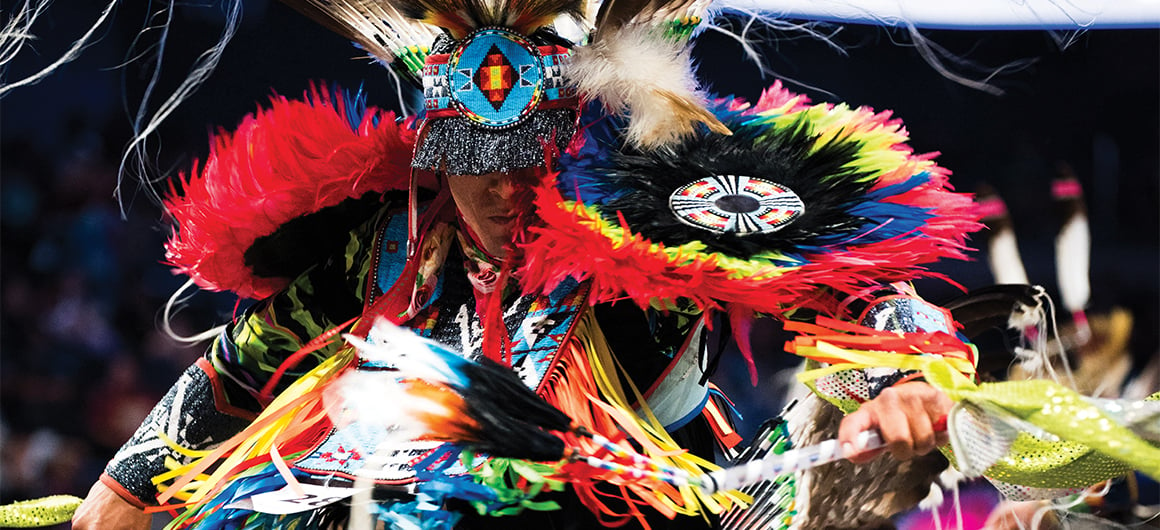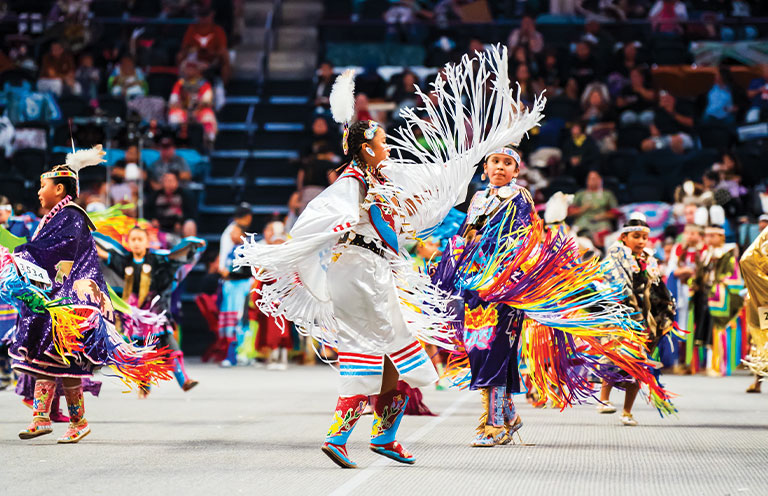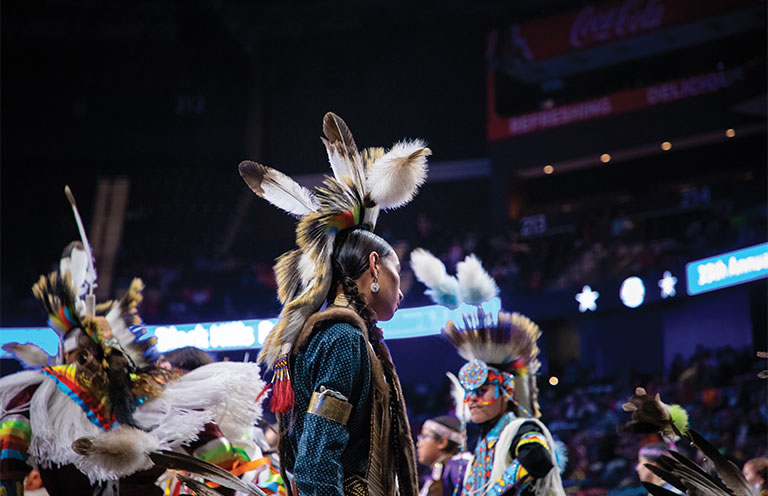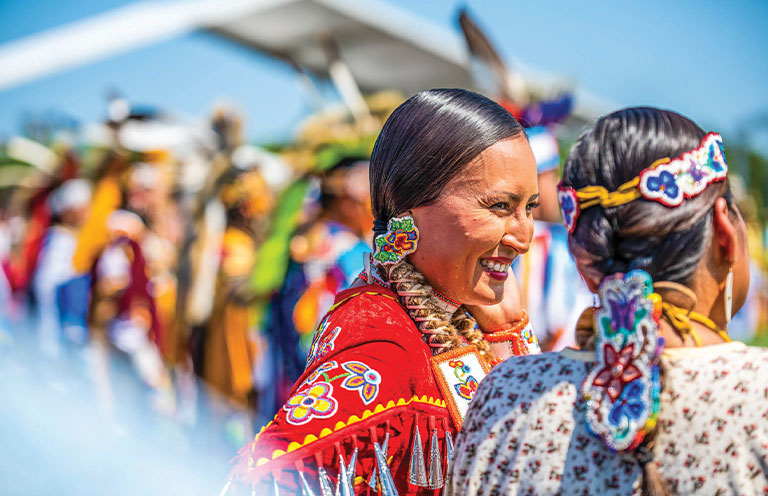The Power of the Powwow
Embracing Native traditions in South Dakota’s Black Hills


The space hummed with the rhythm of the drums, their beat reverberating through the earth and into my chest. Voices rose in chant, a sound both ancient and alive, filling the air with their powerful call as a procession of powwow participants moved through the Summit Arena: tribal elders, veterans, powwow princesses and Native American dancers. They came from tribes near and far, adorned in regalia handsewn with beads, bells and feathers, forming a vibrant living tapestry woven with ancestral stories, myths and traditions.
The Grand Entry, the ceremonial start of a powwow, was a spiritual kaleidoscope of dance, sound and color, radiating joyful energy. Each movement, each gleam of beadwork, each drumbeat drew me deeper into the spirit of the powwow, until I, too, felt part of the ritual.

A gathering for everyone
Prior to attending the three-day Black Hills Powwow in Rapid City, South Dakota, I had no idea that Native American powwows were even open to the public. Until I received an invitation to attend from a colleague, I assumed these gatherings—which honor ancient traditions through dancing, singing and storytelling—were reserved for Native Americans, a group to which I do not belong.
“It’s a celebration for all,” says Dew Bad Warrior-Ganje, vice-president of the Black Hills Powwow. “We invite [non-Native Americans] as long as they come with a good heart and good energy. It’s a way to educate and open doors for better understanding of our culture.”
The inclusivity of the Black Hills Powwow is emphasized through its free onsite presentation for first-time attendees. This one-hour talk, led by members of the Lakota Nation, the indigenous people of the Great Plains and Black Hills, explains key elements of the wacipi (Lakota for powwow). Attending this presentation early in my visit deepened my understanding and made me feel welcome.
Several members of the Lakota told me that attending a powwow is “medicine”—a spiritual remedy meant to heal, restore and renew, and its effects can linger long after the last drumbeat fades. The drum is not merely an instrument—it’s regarded as a living spirit deeply cherished by the Lakota. Its hide, drawn from the body of a four-legged relative, and its wooden frame, carved from one of Earth’s trees, are treated with profound respect. The Lakota nurture the drum as one would a sacred being—feeding it, draping it in protective coverings and shielding it from harm. In return, the drum gives life to the powwow, offering its steady heartbeat and uniting all in rhythm and spirit.

What to expect at a powwow
My printed program and the powwow’s master of ceremonies were key guides to an atmosphere that balanced laid-back festival with formal performance. People came and went, respectfully, as performances took place on the main arena floor, the focal point for dancing and drumming competitions (all with cash prizes) and pageantry.
Captivated by the dance competitions, I often lost track of time, drawn deeper into the stories unfolding before me. Each traditional dance style—like the Grass Dance, Fancy Dance and Jingle Dress Dance—was a living narrative, steeped in culture, history and the unique landscapes of each tribe. The Men’s Grass Dance, for instance, featured swaying movements to mimic the whisper of the wind against the prairie grass. During the Women’s Fancy Dance, the dancers used their colorful fringed shawls to symbolically trace the path of a deer or a butterfly, the shawls’ edges fluttering in a vibrant blur as the women moved with a light-footedness that emulated the animals.

Regalia—the culturally appropriate term rather than the often misused “costume”—is worn with deep pride and responsibility by Native American dancers, some as young as toddlers. It can take months, sometimes years, to handcraft the garments, which often tell a meaningful story, such as a personal connection to the land or a special tribute to an ancestor. Each was unique and beautiful. Most dancers were happy to have their photos taken, if I asked permission first.
Surrounding the dancers, more than a dozen large drums encircled the arena, with registered drum groups performing at scheduled times, providing the powwow’s rhythmic heartbeat. The chanting and singing that accompanied the drumming were among the most passionately performed music I’ve ever witnessed.

Celebration and connection
I spent much of my time moving between the exuberance of the arena and the calmer scene of the Native American market, where vendors sold jewelry, drums, clothing and dreamcatchers—a handmade hoop and net that is traditionally used to protect sleepers from bad dreams and evil spirits. I bought one for my 3-year-old daughter, who had been having bad dreams at the time.
The family atmosphere of the powwow was a sight to behold—strollers gliding past the elaborately dressed dancers, and parents feeding babies while preparations unfolded around them. Even the youngest dancers were already learning the sacred ways of their ancestors. Hugs and laughter among families and friends surrounded me, turning the powwow into sacred space.
This was indeed unexpected medicine: a reminder of the powerful bonds of love, connection and legacy. More than a simple travel memory, the deep booming of the drums still vibrates in my chest, while the kaleidoscopic whirl of dancers remains forever etched in my mind.
. . . . .

Finding a powwow
The Native American powwow season runs from spring to fall, with more than 1,000 celebrations across the country. They range from small gatherings to large, multi-day events. Powwows.com is a great resource to find one near you. Here are some popular ones held annually.
